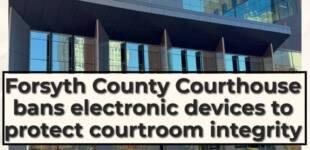PTRP project may benefit East Winston
The sea of gravel and construction machines adjacent to the Piedmont Triad Research Park (PTRP) near the union of Business 40 and Highway 52 won’t stay an eyesore for long.
The city is currently partnering with the Research Park – home to a number of innovative technology and bio-tech firms – to create a two-acre storm water retention pond, according to Mayor Allen Joines. The pond, which will occupy the southern corner of the park closest to the two highways, will have a practical use for the city and Research Park tenants, preventing flooding and erosion in the area. But Joines said the two groups decided to make the most of the project by turning it into a community amenity as well. While the water won’t be able to be used for recreational activities such as fishing or swimming, it will be a strong aesthetic anchor for the city and the park, Joines said.
“The lake itself is part of the storm water retention system, but we’re going to make it an amenity with landscaping and a walking trail around it,” he explained. “…We felt like if we could make it an attraction and an amenity, it could be a good thing for the city and also something folks from downtown and East Winston could come and enjoy.”
The proposed walking trail encircling the pond will connect to a second initiative, the Rails to Trails project.
Rails to Trails aims to repurpose unused NCDOT-owned railroad tracks owned by converting them into bike and walking greenways. In this case, with city, state and PTRP funding, Rails to Trails would connect the proposed park walking trail to the existing Salem Creek Greenway, a 4.5-mile trail that extends from Peters Creek Parkway to Salem Lake and is popular among bikers and pedestrians alike.
Winston-Salem resident Ralph Womble is one of the Rails to Trails project’s biggest proponents. Womble, a member of the NCDOT’s Board, said the project would be an asset for local residents for both recreational and transportation purposes, as a rail bed is flat and easy to navigate on foot.
“This is not only just an exercise path. This is transportation,” said Womble, a retired CEO of Hanes Companies, Inc. “This is a really neat use of existing infrastructure.”
Joines said he is hopeful the Rails to Trails project will help to connect East Winston residents with downtown areas and establish a more cohesive community.
“With these amenities and the work we’re doing there, hopefully, it’s kind of bridging the gap between downtown and the East Winston community,” Joines commented. “We’re trying to create something special for both neighborhoods to come in and enjoy.”
Womble said the project is a conscious effort to right some of the wrongs of the past.
“If you go back to the ’50’s …(Interstate) 52 and everything like that was viewed as a divider. Now, we’re making efforts to use it as a connector, stitching back together the wrongs of the ’50s and ’60s.”
East Ward City Council Member Derwin Montgomery, whose ward encompasses the project, said new construction is sorely needed in the East Winston community. He believes the Rails to Trails project is a viable first step in the process.
“We’d like to see more investment like this, not just in the area of the Research Park, but extending into East Winston. Hopefully, it will help to spark some additional activity,” he said.
Grayton Pleasants, who has overseen the real estate development for the Research Park for more than a decade, said both Rails to Trails and the aesthetic landscaping elements that will be included within the storm water retention project will add value to the Park and to the city it calls home.
“If you look at urban development and where the national trends are going, having quality green space is a central element, so it’s one of the pieces of the puzzle that we hope will help make our city a better place to live, work and play,” he said of the area, which developers are have tentatively named Bailey Park at East End.
Two other construction projects are also in progress at the park: the Salem Creek Connector, a street that officials say would extend from the Research Park area to Martin Luther King Jr. Drive near Bowman Gray Stadium, and the Research Park Boulevard, a road that would run from the nearby Third Street through the Research Park and over to Rams Drive (formerly Stadium Drive).
“We’re very excited. The scale of change here is really unparalleled by many places in the country,” Pleasants said of the projects. “By mid 2013, we should have Research Boulevard completed, the storm water pond in and landscaped and the sides around that grated and grassed. It will be very different.”









